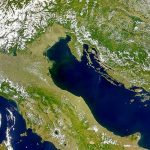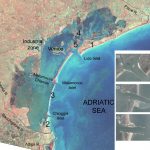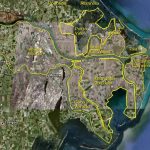The Host Laboratory for the Po Delta – Venice Lagoon Supersite will be CORILA (Consortium for Coordination of Research Activities concerning the Venice Lagoon System).
The Supersite will span the watershed and the lagoons of Venice and Grado-Marano, located in the northeastern Adriatic Sea (Italy) bordered by the North Adriatic river system, and the Po River with its delta-lagoons system.
The Venice Lagoon is the largest Mediterranean lagoon and one of the most heavily altered by a millennium of human activity. The shallow transitional areas are covered by tidal flats and salt marshes, with some areas are constantly submerged, and separated from the sea by longshore bars. Major changes have been the deviation of larger rivers that discharged inside the lagoon, the dredging of the inlets and the construction of jetties to keep the depth to shippable values, and the construction of artificial channels for navigation. Recent construction of storm surge barriers has added another level of complexity to the manmade changes in the lagoon.
The Po, discharging into the Adriatic Sea, is the largest Italian river draining an area of 74,000 km2. Five branches discharge into the Adriatic Sea, with the main plume around the Pila mouth. The injection into well mixed sea waters, combined with meteorological conditions, generally does not allow a full spreading offshore. The dynamics of the discharge has long been studied from hydrodynamic and sedimentological perspectives. The Po River transports fine sediments mainly forming mud that, during low-discharge periods, is deposited inshore. Deposition also occurs inside some branches of the river due to the formation of flocs inside the river channels. One third of the discharge is regulated by human activities, such as hydropower and irrigation. The Po is a transport waterway with fishing and shellfish farming and, carries large amounts of pollutants from large cities and agricultural areas. There are concerns over the stability and sustainability of the coastal lagoons of the North Adriatic due to anthropogenic impacts such as: tourism, fishing, industry, and passenger cruise terminal.
The Supersite will provide a facility for investigation of the present and future dynamics of a lagoon system, including natural and anthropogenic variations.
The Supersite will provide facilities, equipment and expertise. The existing observational system in the coastal environments of the Northern Adriatic Sea includes oceanographic buoys and long-term stations for continuous monitoring of meteorological and physical chemical parameters in the water column, at the air-water and bottom interface. Several fixed platforms are currently operating. A series of five hydro-bio-chemical stations, located in the Venice Lagoon, is an integral part of the monitoring system. Other systems include groundwater and ground dynamics monitoring networks.









